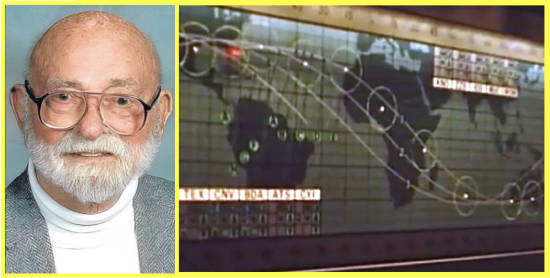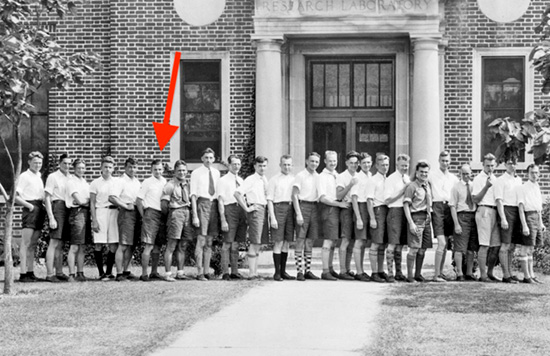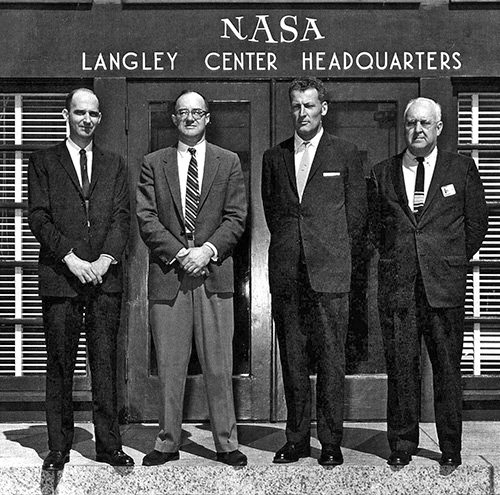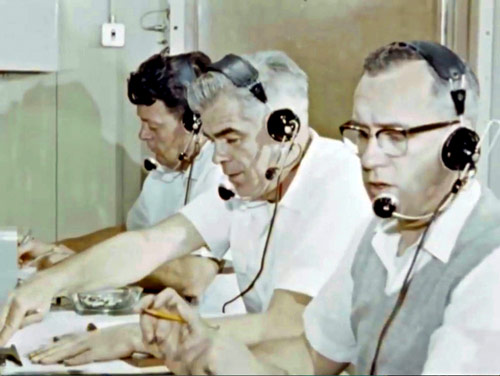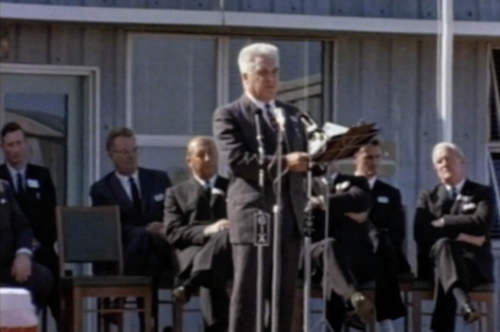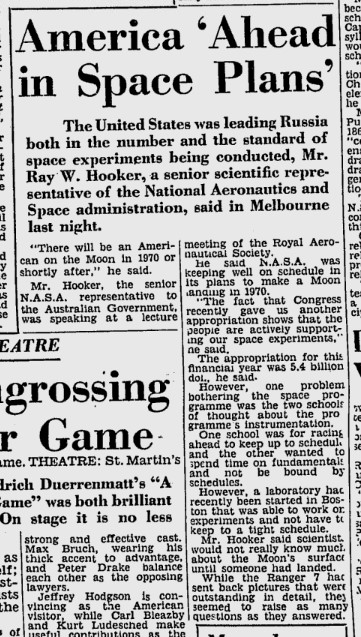Ray Willard Hooker
1906 – 2013
Second NASA Senior Scientific Representative to Australia
Ray Hooker. Right: The plotboard in Mercury Mission Control. |
Ray Willard Hooker served as NASA’s second Senior Scientific Representative to Australia, from 1964 to 1966.
Ray Hooker was born in a farmhouse in Warren County, Indiana on 03 January 3 1906, and grew up in the small town of Pine Village, about 30km west of Lafayette. He did well at high school, and was named valedictorian.
After high school, his interest in flying, and wanting to know how things work, led him to Purdue University in Lafayette, where, in addition to his studies, he was active in sports and joined the wresting team. In this he excelled, and was Big Ten champion for 2 years, and named All-American in 1929.
That year he graduated with a degree in Mechanical and Aeronautical Engineering and soon found employment as a Junior Engineer with the National Advisory Committee for Aeronautics’ Langley Memorial Aeronautical Laboratory at Langley Field in Hampton, Virginia.
Edwin P. Hartman, who would become NASA’s first Senior Scientific Representative in Australia, also began his engineering work at Langley in 1930, so would have been contemporary with Hooker.
Another contemporary was Edmond C. Buckley, who had graduated with a Science degree majoring in Electrical Engineering from Rensselaer Polytechnic Institute in Troy, NY. Buckley also started at Langley in 1930.
Hooker, Hartman and Buckley would each go on to make significant contributions in aeronautics and in the early days of manned space flight.
Langley’s engineers wearing shorts during a summer heatwave on 3rd September 1930. Ray Hooker, arrowed, is sixth from left. “Langley Memorial Aeronautical Laboratory: Langley’s staff of young engineers wearing shorts to beat the summer heat of Tidewater in 1930. From left to right: Harvey Herring, Irvin Coates, Warren Weiss, Clindon Glass, W. M. Martin, Ray W. Hooker, W. K. Ritter, Eastman Jacobs, Robert Mixson, John Stack, George Hammeter, Joseph A. Shortal, Kenneth Ward, R. E. Tozier, C. D. Waldron, Charles H. Zimmerman, Gilbert Strailman, Melvin Gough, Everett Johnson, Elton W. Miller, Fred Schultz, Ira H. Abbott, and Addison Rothrock.” NASA Image Number: EL-1999-00358. |
Langley
Formed just twelve years earlier, in mid-1917, the Langley Memorial Aeronautical Laboratory was the place to be when it came to aeronautical research, and Hooker was soon involved in testing aircraft designs using wind tunnels. He authored several papers, such as “The Aerodynamic Characteristics of Aerofoil as affected by Surface Roughness”, NACA Technical Note No. 457, April 1933.
In 1942, Hooker was given responsibility for the design and construction of Langley’s West Area. This included the building of several wind tunnels. These were key tools in evaluating new aircraft designs and diagnosing problems with aircraft already in production.
From 1945 to 1947 he was made engineer in charge of the development of the Pilotless Aircraft Research Station at Wallops Island Station in Virginia.
NASA and Project Mercury
On October 1 1958, the National Advisory Committee for Aeronautics (NACA) became the nucleus of the new National Aeronautics and Space Administration (NASA). In 1959, the Pilotless Aircraft Research Division at Langley was transformed into the NASA Space Task Group (STG) for the man-in-space program. STG was to develop the hardware and systems for Project Mercury.
At the same time, Langley’s Assistant Director, Hartley A. Soule’, created the Tracking System Study Group to investigate what would be needed to track and communicate with the man-in-space.
The group initially included Hartley Soule’, Edmund C. Buckley, James J. Donegal, Ray W. Hooker, George B. Graves, Frances Smith, Paul Vavra and H. William Wood. [von Ehrenfried, p. 84.]
Initial work showed that a network of tracking stations around the world be needed to support Project Mercury. As well, a reliable worldwide communications network would be required to connect them together. It would be a huge task.
On January 26 1959, the Tracking System Study Group became the Tracking and Ground Instrumentation Unit (TAGIU) as a separate group complementing the STG. Leadership of TAGIU was assigned to George (Barry) Graves. The members and areas of responsibility were:
George B. Graves – Electronics, Head of TAGIU
Paul Vavra – Assistant to Graves
James J. Donegan – Computers
H. William Wood – Logistics
Ray W. Hooker was assigned to head Site Selection and Architect and Engineering services. [William Corliss page 87.]
Both George Graves and Hartley Soule’ appear in this photo taken at Langley Research Center in Virginia 3rd April 1959.
Australians George Barlow and Tom Lawrence were at Langley to discuss the establishment of NASA tracking stations in Australia.
Left to right: George B. Graves Jr (Langley), George E. Barlow (Civilian Defence R&D Representative at the Australian Embassy in Washington), Tom F.C. Lawrence (Weapons Research Establishment, Salisbury, South Australia) and Hartley A. Soule’ (Langley).
From George Barlow via June Lawrence, scanned by Mike Dinn.
Hooker was largely responsible for the preparation of Mercury Network sites. The very short lead time to build a network before the first Mercury flights meant that tracking sites around the world were being built simultaneously – all between April 1960 and March 1961.
The Mercury Space Tracking Network for MA-8. Scan from a poster preserved by Jack Duperouzel. |
Hooker travelled extensively and was closely involved in negotiating the use of sites for tracking facilities, including Nigeria and Zanzibar. In all these negotiations, he stressed that “that the National Aeronautics and Space Administration was a civilian scientific organization and that Project Mercury was a scientific experiment being conducted for the purpose of ascertaining the problems of man's existence in space. Furthermore, that the results from this experiment will be made available to all the world”. [Corliss p. 123, 124]
Kano Tracking Station in Nigeria – from a NASA film of the Friendship 7 flight. |
At the Kano (KNO) Flight Control Console, during Friendship 7, 20 February 1962. Left to right: Cyrus Rumbaugh (Kano Systems), Eugene L. Duret (Kano Capcom), and Dr. Clyde Kratochvil (Aeromedical Monitor). Screenshot from the NASA film “Friendship 7”. |
Australia
After the success of Project Mercury, Hooker was appointed as the second NASA Senior Scientific Representative to Australia, succeeding Ed Hartman.
He arrived in Australia in April 1964, according to a report in The Canberra Times (Saturday 15 October 1966, page 25).
Both men were present at the opening ceremony for Carnarvon Tracking Station on 25 June 1964. Hartman was still listed as the NASA Senior Scientific Representative at the time of the event, and Hooker’s address was listed as c/- the NASA Senior Scientific Representative.
Ray Hooker may possibly be the second from the left in this frame from footage of the opening of Carnarvon Tracking Station, 25 June 1964. Left to right: Lewis Wainwright (Carnarvon Station Director), (?) Ray Hooker, Allan Fairhall (Minister for Supply), Edmond Buckley(NASA), ??, John Knott (Aust. Departmemnt of Supply). |
At the beginning of August, he submitted to Edmond Buckley (now at NASA Headquarters) the Australian Representative’s “Activities Report for July 1964”, so it seems the handover from Hartman to Hooker took place shortly after the Carnarvon opening.
Hooker was present in Australia at a key time in the build up of NASA tracking activity. During his two years in Australia he saw considerable activity and the building up of NASA’s tracking capabilities –
Rob South uncovered this clipping from an Australian newspaper, September 1964. |
After his term in Australia, Hooker returned to the USA, having handed over to Willson Hunter who was arriving in Melbourne on 17 October 1966 (according to the same brief report in The Canberra Times, Saturday 15 October 1966, page 25).
Ray Hooker’s published obituary revealed that over the years whcih followed, he and his wife Mary Anne enjoyed many adventures on the Chesapeake Bay and abroad.
Post-retirement, Ray took up golf (at the age of 83), continued to sail with friends and family, and tinkered in his workshop. He learned to fly ultralight aircraft in his 90s. He lived to the remarkable age of 107.
References:
Ray Willard Hooker Obituary – Daily Press, Gloucester, Virginia, 16 July 2013.
Ray Hooker 1906 - 2013 – Purdue Boilermakers, 18 July 2013.
The Birth of NASA – Manfred “Dutch” Ehrenfried, Springer, 2016. page 84.
Histories of The Space Tracking and Data Acquisition Network (STADAN), The Manned Space Flight Network (MSFN), and the NASA Communications Network (NASCOM) – William R. Corliss, NASA CR-140390, June 1974. pages 123-124.
The Canberra Times, Saturday 15 October 1966, page 25 – available via Trove.
A Request:
I have been unable to find any confirmed photos of Hooker during his time in Australia. Can anyone point me to one please? Contact.
